Living Sculptures
The Art & Science of Bonsai
A special exhibition on view January 5 – March 22, 2024
This winter, experience a world of intricate craftsmanship and serene beauty, with miniature masterpieces indoors and their full scale inspirations outdoors.
Experience a world of serene beauty and intricate craftsmanship as Sonoma Botanical Garden, in partnership with the Redwood Empire Bonsai Society, presents Living Sculptures: The Art and Science of Bonsai.
A Living Legacy in Miniature
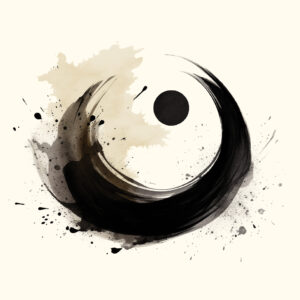
Ancient Origins
Bonsai’s roots lead back to China during the Han Dynasty (206 BCE – 220 CE). Known as penjing, the Chinese practice of creating miniature landscapes that embody yin and yang, the balance of opposites. Penjing artists often feature trees, rocks, water elements, and sometimes miniature figures to evoke more than just natural beauty, but a spiritual connection to nature. Chinese immigrants later brought this art to Japan, where it evolved into what we know as bonsai today.
Simplicity & Tranquility
Under the influence of Zen Buddhism, bonsai adapted to emphasize simplicity, harmony, and a deep connection with nature. Zen monks in the Kamakura period (1185-1333) saw the creation of these living sculptures as a path to enlightenment, teaching patience and mindfulness. The intricate shaping of bonsai mirrored the discipline required in Zen meditation.
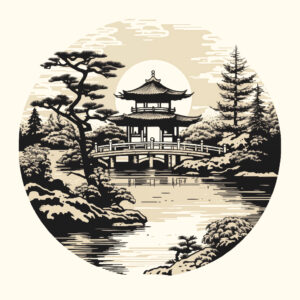
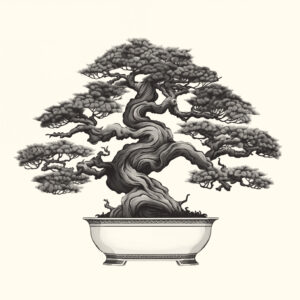
Exquisite Masterpieces
Through the centuries, the art form continued to evolve. By the Tokugawa period (1603-1868), noble families competed to create the most exquisite specimens using specific techniques and shapes to showcase status and prestige.
Timeless Beauty
Popularity blossomed globally and, today, bonsai is a celebrated art form for hobbyists and enthusiasts. Contemporary bonsai artists blend ancient techniques with modern sensibilities, creating a diverse tapestry of styles and expressions. The collection you see here was carefully cultivated by members of the Redwood Empire Bonsai Society.
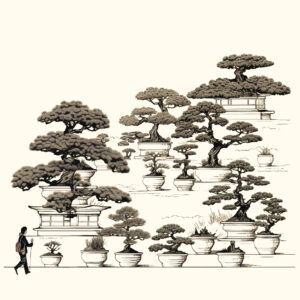

The 2nd Saturday in May is World Bonsai Day. Celebrate with the Redwood Empire Bonsai Society and other groups globally. Sponsored by the World Bonsai Friendship Federation.

Nurturing Nature’s Tiniest Trees
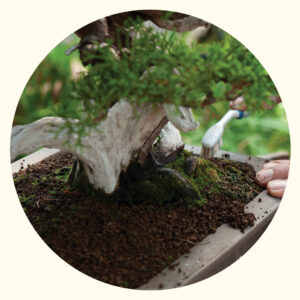
A solid Foundation
One of the fundamental principles of successful bonsai cultivation is the careful selection of the right soil composition. It is typically well-draining, ensuring the roots receive oxygen while retaining enough moisture to sustain the tree by a careful balance of organic and inorganic components. The trees here use an inorganic mix of lava rock, pumice, and akadama or kanuma (volcanic clays imported from Japan). Because the soil is inorganic, supplemental fertilizer is often added to help the tree thrive.
Pruning & Shaping
The shape of a specimen is not just about balance and beauty – a critical part of the art – but also a deep understanding of horticulture. Artists follow the principles of apical dominance, which involves trimming the dominant shoot to encourage branching. Understanding how trees and plants grow allows the artist to manipulate and train the plant to grow into the desired form. This level of meticulous pruning even applies to the roots!
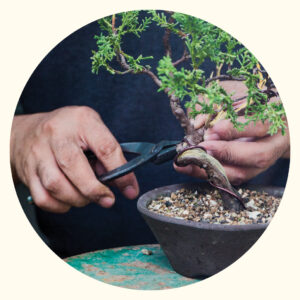
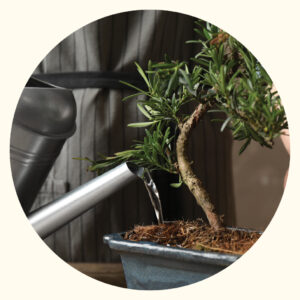
The Art of Water…ing
Bonsai are just as much about the art of watering as it is about the art itself. Over-watering can lead to root rot, while under-watering can cause stress and leaf die-off. Different species have varying water requirements and – as any garden enthusiast will tell you – season, humidity, sun exposure, and more can change how much water any individual needs at any time. Being in a tiny pot makes bonsai even more sensitive to shifts in climate conditions.
Shaping Serenity
Contemporary bonsai styles often select techniques from multiple traditional forms, examining what each individual plant has to offer and following the flow of its natural growth.
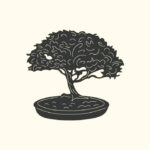
Hokidachi
Distinguished by a straight, upright trunk and branches that radiate outward in a symmetrical, broom fashion, this style exudes a sense of order and balance.
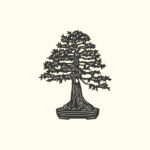
Chokkan
The epitome of grace and symmetry, the formal upright bonsai stands tall with a straight, upright trunk and balanced, evenly spaced branches.
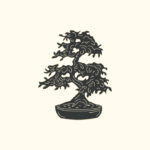
Moyogi
Displaying an organic, natural appearance, the informal upright bonsai boasts a slightly curved, meandering trunk and branches that exhibit a more relaxed and unstructured form.
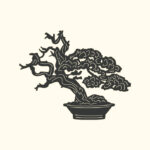
Shakan
Inclined with flair, slanting bonsai trees lean gracefully while maintaining a sense of equilibrium, often portraying the resilience of nature in the face of external forces.

Han-Kengai
A balanced compromise between the upright and cascade, semi-cascade bonsai features a trunk that slants at an angle, with branches delicately extending in a cascading manner.
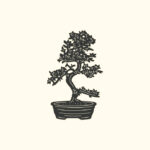
Bunjingi
Characterized by its whimsical, winding trunks and branches, Literati bonsai evokes a sense of aged wisdom and artistic expression.

Fukinagashi
Elegantly shaped to evoke the wind worn effect of nature’s forces, windswept bonsai trees showcase a dynamic trunk and branches that lean in one direction, demonstrating resilience.

Kabudachi
Distinguished by multiple trunks rising from a common root base, the multi-trunk bonsai style offers a captivating representation of interconnectedness.
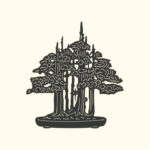
Yose-ue
A harmonious coexistence of multiple trees within a single container, forest bonsai evokes the charm of a miniature forest or grove, symbolizing the interconnected-ness of nature.
Other common traditional forms include:
cascading (Kengai), twin trunk (Sokan), tree-on-a-rock (Seki-joju), clinging-on-a-rock (Ishituki), raft (Ikada buki), and deadwood (Sharimiki).